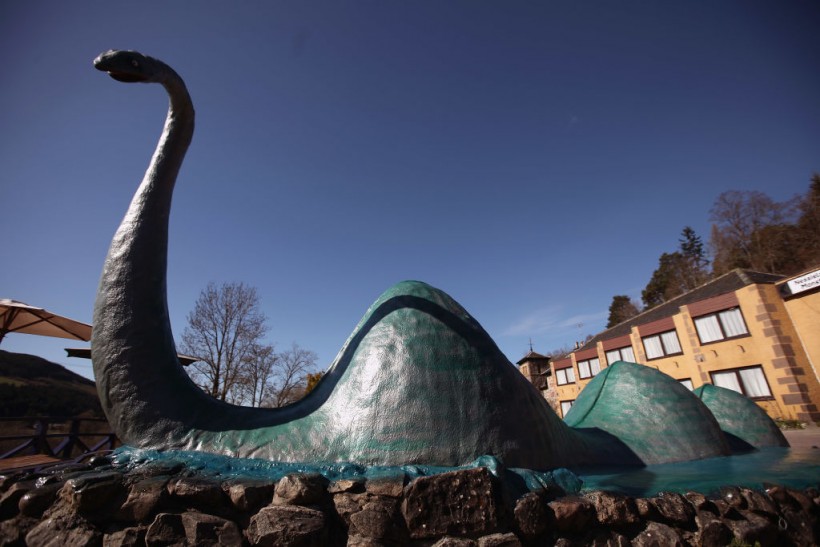According to researchers, the Loch Ness monster may have been a long-necked freshwater dinosaur based on the fossils they unearthed from a 100-million-year-old river system that is now the Sahara Desert in Morocco Daily Star reported.
Experts from the University of Bath said that they found fossils of small plesiosaurs, a long-necked marine reptile from the dinosaur age, that would have lived in Loch Ness in Scotland. Dr. Nick Longrich, who helped produce the study, said that the plesiosaurs were found in freshwater, so they could have also lived in a lake.

A model of the Loch Ness monster stands outside a visitor centre on March 30, 2012 in Drumnadrochit, United Kingdom.
Fossil Remains Points to Plausible Existence of Loch Ness Monster
Researchers from the University of Bath collaborated with experts from the universities of Portsmouth and Hassan II in Morocco to study the fossils, which included neck and backbones, as well as teeth and an arm of a 5-foot baby plesiosaur.
Daily Star reported that the team hinted the creatures used to live and feed in freshwater bodies alongside crocodiles, frogs, fish, turtles, and the aquatic dinosaur called spinosaurus.
Dr. Longrich noted that the isolated bones illustrate what ancient ecosystems might look like. He pointed out that although the plesiosaurs were always referred to as marine reptiles, they could have also invaded freshwater.
Scientists found the fossils in the river system in what is now the Sahara Desert. Most of the bones were believed to come from a 9.8 feet ( 3 meters) long adult plesiosaur, except for the shorter fossil that could have belonged to a baby plesiosaur.
Dr. Dave Martill, a professor of paleontology at the University of Bath, said that the site at the ancient Moroccan river contains various bones of many carnivores that once lived together, which is amazing since it was not a place to go for a swim.
The theory is one of the recent ones that aim to explain the existence of the Loch Ness monster, wherein another theory postulates that it could exist in an alternative universe like the Netflix show Stranger Things.
Ron Halliday, a Scottish, said that Loch Ness could have existed in another universe and that somehow interactions between portals have led some humans in the past to see the mysterious lake monster.
Despite this new claim, some skeptics say it would be impossible for plesiosaurs to live with the Loch Ness monster because they need a saltwater environment. Also, plesiosaurs died 66 million years ago when dinosaurs also died after an asteroid hit Earth.
About Plesiosaurs: Size, Habitat, Facts
According to the Britannica Encyclopedia, plesiosaurs were long-necked marine reptiles that lived 215 million to 66 million years ago during the Triassic Period into the Cretaceous Period. They are widely found in the European seas and the Pacific Ocean, as well as in Australia, North America, and Asia.
Early plesiosaurs were estimated to have grown up to 15 feet (4.5 meters) long that had a broad, flat body and relatively short tail. It was able to swim using its fins, just like how sea lions swim. Experts believed that plesiosaurs used their flexible long necks to move side to side through schools of fish and used their sharp teeth to capture prey.
The early evolutionary line of plesiosaurs suggests that they split into two, wherein one developed a shorter neck and the other one retained its long neck that has become very flexible with 76 vertebrae in its neck. For now, there is no evidence yet to conclude that they were the Loch Ness monster, given that they went extinct alongside other dinosaurs millions of years ago.
RELATED ARTICLE: Bizarre Loch Ness Monster Theory Suggests It Could Just Be a Whale's 'Snake-Like Penis'
Check out more news and information on Loch Ness Monster in Science Times.

![Extinct Giant Salmon Had Tusk-Like Spikes Protruding Out of Its Snout That Can Easily Kill Shark, Other Large Marine Animals [Study]](https://1721181113.rsc.cdn77.org/data/thumbs/full/53304/89/56/50/40/extinct-giant-salmon-had-tusk-like-spikes-protruding-out-of-its-snout-that-can-easily-kill-shark-other-large-marine-animals-study.png)












